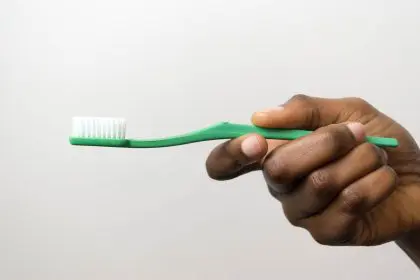Your morning routine might seem ordinary until you notice something that makes you pause at the bathroom sink. That slight pink tinge in the water after brushing your teeth could be more than just aggressive brushing technique. It might be your gums sending an urgent message that shouldn’t be ignored.
Gum disease affects millions of people worldwide, yet many don’t realize they have it until significant damage has already occurred. This silent condition creeps up gradually, often masquerading as minor irritation before evolving into a serious threat to your oral health and overall well-being.
Understanding the warning signs and taking preventive action can mean the difference between maintaining a healthy smile for life and facing costly, painful dental procedures down the road. The good news is that early intervention can often reverse the damage and restore your gums to optimal health.
What healthy gums should look like
Before diving into the warning signs, it’s important to understand what normal, healthy gums actually look like. Picture the perfect shade of pale coral pink, with tissue that fits snugly around each tooth like a well-tailored glove. Healthy gums have a smooth, firm texture without any visible pockets, grooves, or irregularities.
When you run your tongue along your gumline, it should feel even and consistent. There shouldn’t be any tender spots, swelling, or areas that feel different from the rest. Healthy gums also maintain their position consistently, neither receding away from teeth nor appearing puffy or enlarged.
The contrast becomes stark when gums begin to deteriorate. Unhealthy gums often take on a darker red color, sometimes appearing almost burgundy in severe cases. The tissue may feel loose or spongy rather than firm, and you might notice gaps or pockets forming between your gums and teeth.
The two stages every person needs to know
Gum disease doesn’t happen overnight. It progresses through distinct stages, each with its own characteristics and treatment requirements. Understanding these stages helps you identify where you might be in the process and what actions to take.
The first stage, known as gingivitis, represents the early warning system your body uses to alert you to problems. During this phase, inflammation begins to set in as bacteria accumulate along the gumline. The good news about gingivitis is that it’s completely reversible with proper care and attention.
The second stage, periodontitis, represents a more serious escalation of the condition. At this point, the infection has spread deeper into the tissues and bone that support your teeth. While periodontitis cannot be completely reversed, its progression can be halted and managed with consistent professional care and excellent home hygiene.
The 7 warning signs that demand attention
1. Bleeding during routine care
The most common early indicator appears when you brush or floss your teeth. While occasional minor bleeding might occur if you haven’t flossed in a while, consistent bleeding every time you clean your teeth signals inflammation and irritation in the gum tissue.
This bleeding often starts as just a few drops mixed with saliva, but it can progress to more noticeable amounts if left untreated. Some people notice bleeding when they bite into certain foods, particularly harder items like apples or crusty bread.
2. Heightened sensitivity and discomfort
Your teeth and gums might begin reacting more intensely to temperature changes. That morning coffee or evening ice cream suddenly causes sharp, uncomfortable sensations that weren’t there before. This sensitivity often indicates that gum tissue is pulling away from teeth, exposing more sensitive root surfaces.
The discomfort might also manifest during chewing, particularly when eating foods that require more pressure or when biting down on harder textures. This type of pain differs from typical tooth sensitivity because it’s often accompanied by a throbbing or aching sensation in the gum tissue itself.
3. Persistent soreness and mobility
Advanced gum disease can cause your teeth to feel loose or unstable in ways they never have before. You might notice this when eating, speaking, or even just moving your tongue around your mouth. This looseness occurs because the supporting structures around your teeth have been compromised by infection and inflammation.
The soreness associated with this stage often feels deep and constant rather than sharp and temporary. It might worsen throughout the day or after eating certain foods, and traditional pain relief methods might provide only temporary comfort.
4. Changes in how your teeth fit together
Your bite represents a carefully balanced system that has developed over years. When gum disease progresses, it can alter this delicate balance in noticeable ways. You might find that your teeth don’t come together quite the same way when you close your mouth, or that certain areas feel higher or lower than they used to.
These changes can affect how you chew food, potentially causing you to favor one side of your mouth over the other. Some people notice clicking or popping sounds in their jaw joints as they adapt to these changes in their bite pattern.
5. Chronic unpleasant breath
While everyone experiences occasional bad breath, persistent halitosis that doesn’t improve with regular brushing, flossing, and mouthwash use often indicates bacterial overgrowth associated with gum disease. This type of bad breath has a distinctive quality that differs from typical morning breath or food-related odors.
The bacteria responsible for gum disease produce sulfur compounds that create particularly unpleasant smells. These odors tend to return quickly even after thorough oral hygiene, making social interactions uncomfortable and potentially embarrassing.
6. Visible recession and pocket formation
Your gums might begin pulling away from your teeth, creating visible gaps or pockets where bacteria can accumulate. This recession often makes teeth appear longer than they used to, and you might notice dark triangular spaces appearing between teeth near the gumline.
These pockets trap food particles and bacteria, creating a cycle where the problem continues to worsen without intervention. The deeper these pockets become, the more difficult they are to clean with regular brushing and flossing.
7. Tissue color and texture changes
Healthy pink gums might begin taking on darker red or even purplish hues as inflammation progresses. The tissue might also change from firm and smooth to puffy, spongy, or irregular in texture. Some areas might appear shiny or glazed, while others might look rough or bumpy.
These visual changes often accompany other symptoms but can sometimes occur on their own, making regular visual inspection of your gums an important part of maintaining oral health awareness.
Understanding the root causes
Multiple factors contribute to gum disease development, and understanding these causes helps in both prevention and treatment planning. The primary culprit is plaque, a sticky bacterial film that constantly forms on teeth. When plaque isn’t removed regularly through brushing and flossing, it hardens into tartar, which can only be removed through professional dental cleaning.
Lifestyle choices play a significant role in gum disease risk. Smoking dramatically increases the likelihood of developing gum problems and makes treatment less effective when problems do occur. The chemicals in tobacco products interfere with normal gum tissue function and reduce blood flow to the area.
Dietary habits also influence gum health significantly. Diets high in sugar and processed foods provide fuel for harmful bacteria, while diets lacking in essential nutrients weaken the body’s ability to fight infection and maintain healthy tissue.
Certain health conditions create additional risk factors. Diabetes affects the body’s ability to process sugar and fight infection, making gum disease more likely and more severe. Hormonal changes during pregnancy, menopause, or other life stages can make gums more sensitive and prone to inflammation.
Some medications contribute to gum disease risk by reducing saliva production. Saliva plays a crucial role in washing away bacteria and neutralizing acids, so reduced saliva flow allows harmful bacteria to accumulate more easily.
Prevention strategies that actually work
The most effective prevention approach combines consistent daily care with regular professional maintenance. Brushing twice daily with fluoride toothpaste provides the foundation, but technique matters as much as frequency. Use gentle, circular motions rather than aggressive back-and-forth scrubbing, which can actually damage gum tissue.
Daily flossing removes plaque and food particles from areas where toothbrushes can’t reach effectively. Many people skip this step, but it’s particularly important for preventing gum disease since much of the problem begins at the gumline between teeth.
Staying properly hydrated supports gum health by maintaining adequate saliva production. Water also helps wash away food particles and bacteria throughout the day, reducing the opportunity for plaque formation.
Regular professional cleanings remove tartar buildup that home care cannot address. These appointments also provide opportunities for early detection and intervention when problems are still manageable.
Lifestyle modifications can significantly reduce gum disease risk. Quitting smoking provides immediate and long-term benefits for gum health. Eating a balanced diet rich in vitamins and minerals supports the body’s natural healing and infection-fighting capabilities.
Stress management shouldn’t be overlooked as part of gum disease prevention. Chronic stress weakens the immune system and can contribute to inflammation throughout the body, including in the gums.
Taking action for better oral health
Recognizing the signs of gum disease is only valuable if it leads to appropriate action. If you’ve identified any of these warning signs in your own mouth, the time to act is now rather than waiting to see if things improve on their own.
Professional evaluation can determine the extent of any problems and develop an appropriate treatment plan. Early-stage gum disease often responds well to improved home care combined with professional cleaning, while more advanced cases might require specialized procedures.
The investment in gum health pays dividends far beyond just oral health. Research continues to reveal connections between gum disease and other health conditions, making good gum care an important part of overall wellness.
Your gums support your teeth throughout your entire life, making their care a long-term investment in your quality of life. By staying alert to warning signs and taking preventive action, you can maintain healthy gums and avoid the complications that come with advanced gum disease.

















